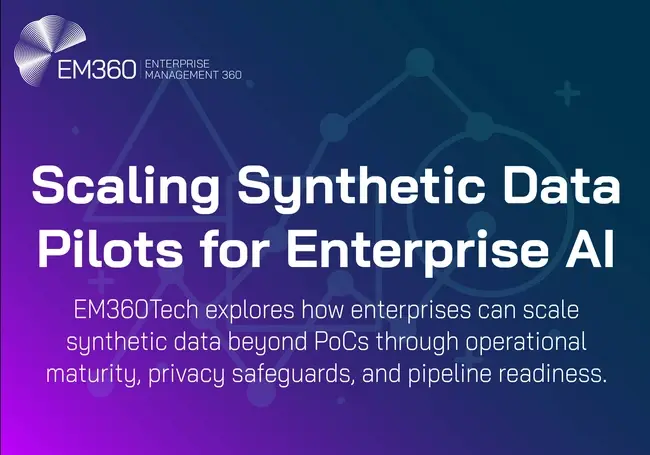Synthetic data has matured. What once powered isolated R&D projects is now being trialled in fraud systems, diagnostics engines, and autonomous platforms. But scaling those pilots is where most enterprises stall.
The shift from testbed to production isn’t about generating more data. It’s about knowing when your synthetic data is actually ready. That means validating quality, building hybrid pipelines, and aligning data generation with governance, not just algorithms.
Right now, AI teams are under pressure. Real-world training data is harder to access. Regulations are tightening. And the demand for scalable, privacy-safe alternatives keeps rising. Synthetic data is one answer — but only if it’s treated like a system, not a shortcut.
Scaling synthetic data pilots requires more than technical skill. It demands operational maturity.

Why Scaling Synthetic Data Is a Strategic Imperative
Organisations are facing mounting pressure to deliver enterprise AI at scale. Access to high‑quality real data is drying up, and privacy laws continue to tighten. Meanwhile, AI model demands are rising—especially as businesses aim for faster innovation and broader automation.
Gartner predicts that by the end of 2024, 60 per cent of data used for AI model training will be synthetic, highlighting how essential synthetic data use cases are becoming. Analysts at Syntho and TechCrunch echo this shift. They warn that without auditing and governance, scaling synthetic data can introduce new risks and biases.
Yet, scaling efforts are failing where it matters most. BCG finds that only one in four organisations has translated AI pilots into real outcomes—meaning 74 per cent have created PoCs that never delivered scale or value. This statistic underscores just how fragile synthetic data pilots are—and why enterprise data strategy must evolve.
Without scale, your pilot is just a sunk cost. Synthetic data alone won’t solve enterprise challenges—it needs to be production‑ready, accompanied by validation processes, and integrated data governance.
From pilot to plateau — what’s getting in the way
Pilot projects often shine in controlled settings but struggle under enterprise complexity for a number of reasons.
- Data quality gaps: Live environments end up with blind spots because synthetic datasets don’t include any edge case examples or data.
- Overfitting risk: Models trained on purely synthetic data often perform well at first, but this performance degrades over time because of the lack of real‑world diversity.
- Compliance fatigue: Teams often discover late in the process that synthetic datasets need full privacy re‑audits—delaying deployment.
- Vendor dependency: Relying entirely on third‑party synthetic data tools can create technical debt and lock‑in.
Further complicating the picture is a debate at the cutting edge of model training. Some researchers warn of model collapse, where iterative use of synthetic data weakens the model, especially on minority data points.
That may be why the AI industry is shifting toward hybrid data pipelines, combining real and synthetic datasets—the only reliable path to production-ready AI.

What makes the difference? Strategic integration, robust data pipelines, and quality validation. Without those, even the most promising synthetic data pilot will plateau.
Traits of a Scale-Ready Synthetic Data Program
Scaling synthetic data is not just a technical upgrade. It is an organisational shift. Teams that succeed treat synthetic data as a programmatic capability, not a one-off solution. That means building the right structure around it — with controls, documentation, and shared accountability.
A scale-ready approach focuses less on how the data is generated and more on how it is governed. That includes provenance tracking, re-identification risk testing, and validation workflows that can withstand both internal and regulatory scrutiny. Nearly 50 per cent of enterprise AI projects struggle due to poor data readiness, underscoring why these steps are not optional — they are foundational.
Equally important is cross-functional alignment. Scaling synthetic data involves more than data science. It requires buy-in from AI leads, data stewards, CISOs, risk officers, and legal teams. If privacy reviews, compliance milestones, or reproducibility checks are left out of scope, pilots stall — or worse, expose the business to unnecessary risk.
Synthetic data quality is only as strong as the governance framework behind it. Before scaling, organisations must establish a foundation that supports sustained, secure, and repeatable deployments.
Checklist for scaling readiness
Use this quick diagnostic to assess whether your synthetic data pipeline is truly ready to move beyond the pilot phase:
- ✅ Source dataset lineage verified
You can clearly trace the origin, format, and sensitivity level of the training data used to generate synthetic outputs. - ✅ Privacy risk audit complete
Independent review confirms no direct or indirect identifiers persist in the synthetic dataset. - ✅ Model overfitting testing passed
The generative model has been evaluated for memorisation, signal leakage, and statistical bias. - ✅ Dataset validated against re-identification risks
Tests include linkage attacks, outlier analysis, and adversarial inference simulation. - ✅ Tooling supports reproducibility and documentation
The generation process is transparent, version-controlled, and includes audit-ready output logs. - ✅ Stakeholder approvals documented
Sign-offs from legal, DPO, CISO, and relevant risk owners are formally recorded, with purpose and access controls defined.
If even one of these is missing, your synthetic data is not ready for scale. These are not just best practices — they are preconditions for privacy-preserving AI.
Framework: The Pilot-to-Production Maturity Curve
Most synthetic data projects never formally graduate from the pilot phase. That’s not a technical failure. It is a maturity gap.
This is particularly striking when you consider the scale of investment pouring into the space. The synthetic data generation market was valued at USD 288.5 million in 2022 and is projected to reach USD 2.34 billion by 2030, growing at a compound annual growth rate (CAGR) of 31.1%. The growth is real — but maturity is lagging.
To scale synthetic data safely and strategically, enterprises need to understand where they are — and what it takes to move forward. This framework helps teams benchmark their current stage and identify the operational shifts required to advance.

The maturity curve is not just a checklist. It is a lens. It shows which risks are emerging, who needs to be involved, and what governance structures must be in place.
Synthetic data maturity isn’t linear — it’s layered. A production-ready dataset doesn’t just pass tests. It has provenance. It is repeatable. And its risk level is understood by everyone who touches it.
This framework can also support intake forms, model governance reviews, and even procurement decisions for new tooling. The sooner an enterprise knows its stage, the faster it can move forward — without exposure.
Scaling Strategies That Actually Work
Scaling synthetic data takes more than bigger datasets or fancier tools. What separates successful programs from stalled pilots is operational discipline — not just innovation, but intentionality.
Enterprise teams need clear workflows, not just generation scripts. Governance needs to scale with the data. And synthetic outputs must prove their worth in real-world validation — not just controlled benchmarks.
That urgency is only growing. Epoch AI estimates that the global stock of human-generated public text — approximately 300 trillion tokens — could be fully exhausted by 2026 to 2032, depending on how intensely language models are trained. This limitation pushes organisations to look beyond traditional data pipelines and invest in scalable, high-fidelity synthetic alternatives.
McKinsey refers to this as “deliberate practice” — a structured approach to improvement through feedback, iteration, and clarity of purpose. For synthetic data, that means shortening the distance between generation, validation, and outcome.
Apply “deliberate practice” to reduce cost and data waste
The most efficient synthetic data teams don’t overgenerate. They validate early and refine fast. That means running smaller iterations, testing for signal fidelity, and cutting what doesn’t work.
- Set quality gates early in the generation process
- Introduce intentional feedback loops into every sprint
- Validate partial datasets for statistical drift and training efficiency
- Track performance impact per batch — not just end model accuracy
The result: less data waste, lower compute costs, and faster confidence.
Build a hybrid pipeline, not a synthetic-only loop
Enterprise AI models don’t just need volume — they need grounding. Synthetic data is powerful, but substituting it entirely can distort signal or miss edge cases. That’s where hybrid pipelines matter.
- Use synthetic data for augmentation, not full substitution
- Blend real production data into critical paths like edge-case modelling, compliance, or fraud detection
- Include validation steps that test synthetic segments for realism, entropy, and adversarial resilience
Hybrid pipelines also help maintain trust. For stakeholders and regulators alike, traceability beats theory — especially when risk is high and outputs influence decisions.
Scaling isn’t about more data. It’s about smarter use. These strategies turn synthetic generation into a structured, auditable, and value-aligned pipeline — the only kind that survives past the pilot phase.
Measuring Success in Synthetic Data Scale-Ups
Scaling synthetic data is only valuable if the results can be measured. That means moving beyond technical outputs — and into outcomes the business actually cares about.

The right metrics show more than model accuracy. They signal trust, progress, and operational readiness. And they help data leaders prove that synthetic data is not just safe — but worth the investment.
Operational metrics that matter
Teams often track whether the model runs. But when scaling synthetic data, you need to know how well it performs, how safely it behaves, and how cleanly it integrates.
- Coverage and diversity: Does the synthetic dataset represent all key input conditions and edge cases?
- Privacy audit pass rate: How often does the data meet Recital 26 or internal anonymisation thresholds?
- Model performance delta: What is the gain (or loss) when synthetic data is used compared to real-world training sets?
Tracking these metrics early helps avoid overfitting, signal loss, or governance surprises once in production.
Strategic metrics the board will ask for
Beyond the lab, synthetic data has to prove its value in time, risk, and spend. The most successful teams track ROI like they would for any strategic investment.
- Time-to-deployment: Are models going live faster with synthetic data in the pipeline?
- Risk reduction: Has synthetic data reduced exposure to compliance incidents or security breaches?
- Compliance cost savings: Are DPIA reviews, cross-border restrictions, or legal reviews less resource-intensive?
These indicators link synthetic data to outcomes that matter to legal, security, and executive teams — not just data science.
What good looks like
There’s no single benchmark. But high-performing teams often share a few traits:
- Audit-ready documentation for every dataset
- Performance parity with real-world training data
- Reusable pipelines that reduce development cycles by 20–40 per cent
- Privacy scores that meet or exceed regulatory thresholds
If your synthetic data program supports faster decisions, stronger privacy, and measurable gains — it’s doing its job.
Success is not about generating more. It’s about showing that what you generate works — and holds up under pressure.
Final Thoughts: Scaling Success Requires Operational Maturity
Scaling synthetic data isn’t about generating more — it’s about making it count.
From pilot to production, the shift that matters most is operational maturity. That means validated outputs, governed pipelines, and the right people in the loop from day one. When done right, synthetic data doesn’t just support enterprise AI — it strengthens it.
The real value lies in how the data is used, trusted, and measured. That’s what turns a promising proof of concept into something that holds up in the boardroom.
For more insight into what it takes to operationalise emerging tech, explore what’s trending across EM360Tech.







Comments ( 5 )
Ali Behbehani
29/07/2025
Michael Lodge
29/07/2025
Ben King
29/07/2025